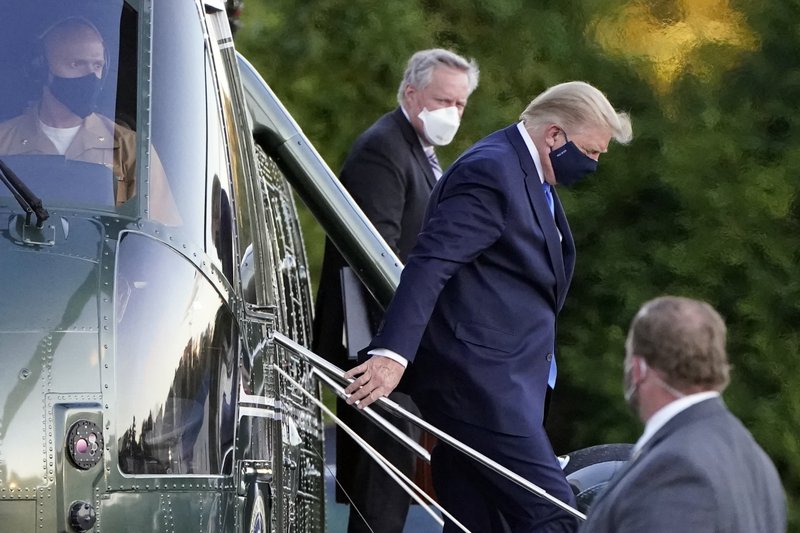One month from Election Day, President Donald Trump is facing a credibility crisis as yawning as his health crisis, at a moment when he needs the public’s trust the most.
The president’s coronavirus infection, as well as the illnesses of several aides and allies, has imperiled the highest levels of the U.S. government. The White House’s efforts Saturday to project calm backfired in stunning fashion, resulting in a blizzard of confusing and contradictory information about the health and well-being of the commander in chief. A cleanup effort on Sunday did little to increase confidence, with Trump’s doctor saying he was trying to project an “upbeat attitude” while also revealing new details about the president’s condition that he had not previously disclosed.
It’s a moment months in the making, the collision of Trump’s repeated defiance of his own administration’s guidelines for staying safe during the pandemic and his well-known disregard for facts. The result: deep uncertainty for Americans over whom and what to believe about the health of the nation’s leader at a perilous moment in U.S. history.
“This is bigger than Donald Trump. It’s about the institution of the presidency,” said Robert Gibbs, who served as President Barack Obama’s first White House press secretary.
For any president, credibility in a crisis is paramount — the ability to rally Americans of every political persuasion around a commonly accepted understanding of the situation. For a president on the brink of an election, particularly one held in as tumultuous a year as 2020, it could be the difference between serving one term or two.
Yet Trump has squandered widespread credibility from the very start of his presidency, spending his first full day in office disputing official tallies of the crowd size at his inauguration and asking Americans to disregard photographic evidence showing that he drew fewer people to the National Mall in Washington than his predecessor.
The episode set the tone for the rest of his administration, with Trump creating alternate realities around issues big and small, amplified by the help of friendly media outlets. He frequently touts records and milestones that don’t exist. He spreads baseless rumors about his political opponents, including declaring without evidence that Joe Biden, his Democratic rival in the 2020 presidential campaign, might be on drugs in their debate.
Yet Trump’s credibility has come under even greater scrutiny during the pandemic, the single biggest test of his presidency. He’s repeatedly downplayed the threat of the virus in public, despite telling journalist Bob Woodward privately in February that COVID-19 was more deadly than the flu. He’s floated unverified and harmful treatments, including suggesting Americans could inoculate themselves by injecting bleach.
In April, just weeks after the pandemic took hold in the U.S., only 23% of Americans said they had high levels of trust in the information the president was providing the public about the virus, according to a poll from The Associated Press-NORC Center for Public Affairs Research.
As Election Day draws near, Trump has increasingly flouted public health guidelines and many of the scientists advising his administration, eager to make the case to voters that the worst of the pandemic that upended nearly every aspect of American life is behind them.
For weeks, Trump has been traveling across the country holding large rallies and hosting events at the White House without social distancing or requiring guests to wear masks. That includes a crowded ceremony in the Rose Garden last weekend to announce the Supreme Court nomination of Judge Amy Coney Barrett. Several attendees, including two U.S. senators and first lady Melania Trump, have since announced they have tested positive for coronavirus.
They, and the president himself, are now among the more than 7 million Americans who have been infected. More than 205,000 Americans have died.
It’s not clear how Trump became infected. He announced on Twitter at 1 a.m. Friday that he and Mrs. Trump had tested positive for the virus; the following evening, he was transported via the presidential helicopter to a military hospital just outside of Washington. The only details the White House provided were that the hospitalization was precautionary and that Trump’s symptoms were mild.
On Saturday, the White House tried to fill in the details with a televised briefing by Trump’s physician, who painted a sunny picture of the president’s situation, emphasizing that he was still working, walking on his own and not laboring to breathe. But Dr. Sean Conley notably refused to provide some specific details, including repeatedly sidestepping questions about whether the president had at any point required oxygen.
Shortly after, and off camera, White House chief of staff Mark Meadows gave journalists a more troubling depiction. After describing Trump’s symptoms as “mild” the previous day, Meadows now said the president’s situation had been “very concerning.” Though his health was improving, Meadows said the next 48 hours would be critical.
On Sunday, Conley conceded that he had been trying to be “upbeat” in his assessments. But his second briefing revealed how much he had withheld: the fact that the president had required supplemental oxygen on Friday morning and that the president was given steroids because of a second drop in oxygen levels on Saturday. Conley said Sunday that he didn’t know whether Trump required supplemental oxygen on Saturday and that he would have to ask the nurses. He also sidestepped questions about the results of Trump’s lung scans.
Still, Conley said the president could be discharged from Walter Reed as soon as Monday.
To those who have grown weary of Trump’s record on transparency and the truth, there was little hope that the coming days would bring a greater level of clarity.
“These are the patterns of this presidency, and for Trump, the patterns of a lifetime,” said Peter Wehner, a Republican who served in President George W. Bush’s administrations and a Trump critic. “There’s no reason to believe he or his inner circle are going to change.”
(AP)












One Response
ANOTHER ANTI-TRUMP FAKE NEWS PIECE.WE ARE SICK OF THIS YWN!!!!!